#pororoca
Text
Did Farragut Ever Experience Tsunami? 🌊
To be precise, in Brazil (November 1842)? Or on his sail back to Chesapeake Bay in winter 1842-43, somewhere in the Carribean?
At least that was what initially crossed my mind when I first read relevant passages in his biography (by Loyall still!).
.
So, on to the first instance. To set the stage — after being in Buenos Aires since June 1842, Commander Farragut (on USS Decatur) was ordered to sail home (to Chesapeake Bay — Norfolk Navy yard). The ship made several stops along the South American Atlantic coast — and they made one such stop near the mouth of Paraíba river. They made it inland as they sailed upstream the river, to a place named Boa Vista.
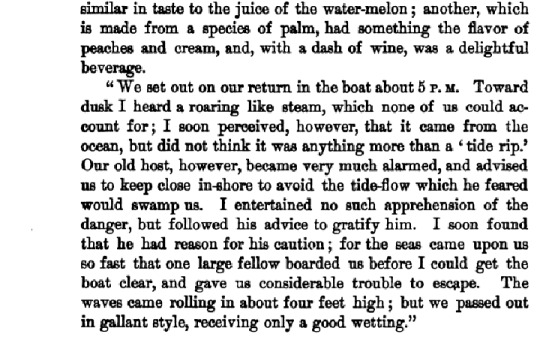
"We set out on our return in the boat about 5 P. M. Toward dusk I heard a roaring like steam, which none of us could account for; I soon perceived, however, that it came from the ocean, but did not think it was anything more than a 'tide rip'. Our old host, however, became very much alarmed, and advised us to keep close in-shore to avoid the tide-flow which he feared would swamp us. I entertained no such apprehension of the danger, but followed his advice to gratify him. I soon found that he had reason for his caution; for the seas came upon us so fast that one large fellow boarded us before I could get the boat clear, and gave us considerable trouble to escape. The waves came rolling in about four feet high; but we passed out in gallant style, receiving only a good wetting."
.
On a second read, this might seem more like pororoca (tidal bore happening on the Amazon and adjacent rivers flowing into the Atlantic ocean) rather than a fully fledged tsunami (though I must admit I could neither ascertain for one or the other, only surmise). What made me surmise it more as pororoca was the lack of registered earthquake in the record. While the peaks of pororoca happens during equinox (in March and September — the ship only reached Paraíba around November), it usually happens during new and full moons. Farragut and his crews might not have experienced the bore at its peak (4 feet wave compared to 13 feet wave at its peak), but it seems like in the end that's what they might have experienced.
.
Now the second instance.
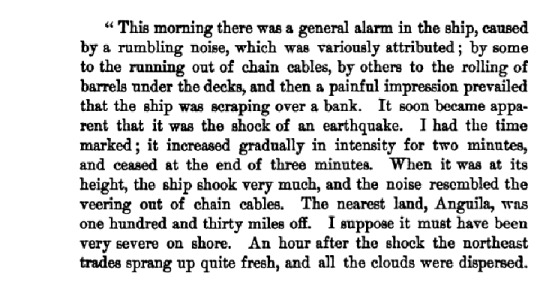

"This morning there was a general alarm in the ship, caused by a rumbling noise, which was variously attributed; by some to the running out of chain cables, by others to the rolling of barrels under the decks, and then a painful impression prevailed that the ship was scraping over a bank. It soon became apparent that it was the shock of an earthquake. I had the time marked; it increased gradually in intensity for two minutes, and ceased at the end of three minutes. When it was at its height, the ship shook very much, and the noise resembled the veering out of chain cables. The nearest land, Anguila, was one hundred and thirty miles off. I suppose it must have been very severe on shore. An hour after the shock the northeast trades sprang up quite fresh, and all the clouds were dispersed.
There appeared to be a sympathy between the earthquake and the weather."
.
This one struck me more plausibly as tsunami, not only because of the recorded earthquake, but also because of the loud noise (which is also the signs of impending tsunami). Being at sea, one couldn't record for another sign that usually noticed on the coast — the sudden, far receding of the tide (so again, this phenomenon being tsunami is more surmised than ascertained).
.
What do you think? What happened to Farragut and his crew during this two instances?
#writings#american history#somewhere in the world it's still...#farragut friday#(ugh finally back again!! 🤦🏾🤦🏾💀)#david farragut#david glasgow farragut#this ends up taking longer to write up 👀🙈#(i initially intended this to be just a trivial write up 🙈)#tsunami#pororoca#naval history
3 notes
·
View notes
Text
Surfisti in Amazzonia sfidano la "Pororoca"
È una delle onde più popolari tra i surfisti, nel fiume Mearim in Brasile. Può raggiungere quattro metri
0 notes
Text
Peixemon: Pororoca
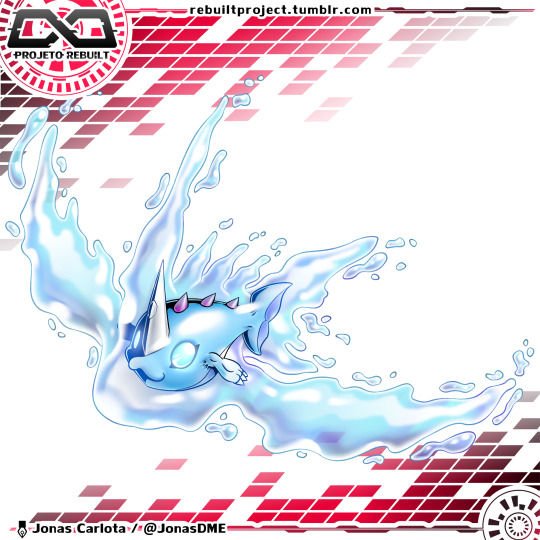
Nível Adulto
Atributo Vacina
Tipo Peixe Tropical
Campo Salvadores das Profundezas (DS)
Significado do Nome Peixe
Descrição
Quando Peixemon: Alto Poder ultrapassa seu próprio potencial, uma nova transformação ocorre, fazendo-o evoluir para uma forma que manifesta o elemento da Água como uma grande aura que o envolve.
Sua velocidade foi ainda mais acentuada com a evolução, tornando-o um adversário difícil de se enfrentar pois nunca se sabe de onde ele virá, e, mesmo que consiga pará-lo de alguma forma, a Aura que o envolve possui a propriedade de congelar toda a superfície que toca, impedindo qualquer abordagem física.
Sempre que se locomove, o ar por onde passa cai de temperatura e o chão fica congelado, criando um ambiente glacial onde quiser, o que, para uns, é um espetáculo de se ver, mas para outros é a certeza de que estão para “entrar numa fria”.
Técnicas
Chifre d’Água II (Aqua Horn II) Avança contra o oponente em alta velocidade e o atravessa com seu chifre, congelando-o devido ao contato com o a Aura, impedindo que recupere a área atingida.
Bolha Aquática II (Aquatic Bubble II) Atira uma grande bolha de água que, ao atingir qualquer superfície, explode e congela completamente o ambiente ao redor e os inimigos próximos.
Informações Adicionais
Pororoca
Esta é a Evolução do Alto Poder, atingida quando o Digimon ultrapassa seus próprios limites.
Mesmo o Digimon mantendo a aparência de sua forma original, este Modo é uma Evolução, com o diferencial de que o indivíduo manifesta uma aura composta de seu elemento predominante.
Outra característica interessante é que o poder oscila muito enquanto está neste estado, sendo um problema a princípio em função da dificuldade em saber quando seus ataques estarão no potencial máximo, mas conforme o Digimon domina a Pororoca, melhor ele fica na hora de administrar os picos de poder.
Infelizmente não é possível ficar muito tempo neste Modo, mesmo sendo considerado uma evolução, pois é dito que se o Digimon se sobrecarregar demais, sua Ruína será certa.
Linha Evolutiva
Pré-Evoluções
Peixemon
Evolução
Nexusmon (Jogress com Heatmon: Pororoca)
Artista Jonas Carlota
Digidex Empírea
#dmedex#digimon#digital#monster#rebuilt#rebuiltproject#Fanmade#digifake#fakemon#oc#original character
33 notes
·
View notes
Text
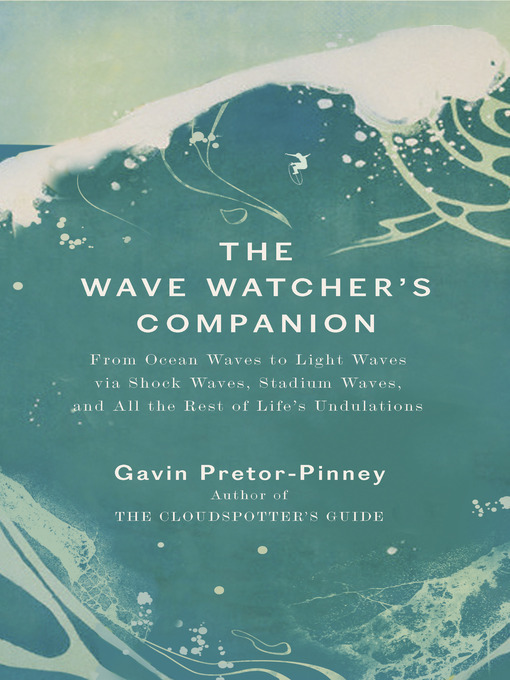
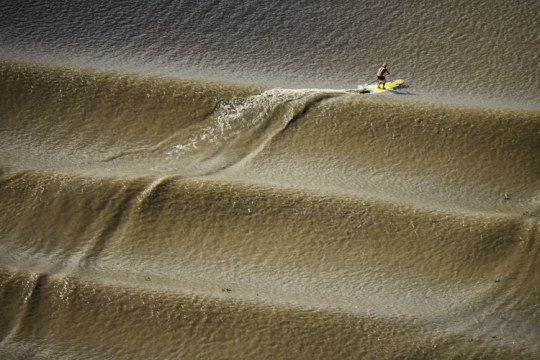

The Wave Watcher's Companion: From Ocean Waves to Light Waves via Shock Waves, Stadium Waves, and All the Rest of Life's Undulations
by Gavin Pretor-Pinney
The images of the tidal bores (Pororoca at the mouth of the Araguari River in Brazil, Qiantang River/Hangzhou Bay in China). The screenshot below is from the Wave Watcher's Companion book in the section about the traditional Micronesian navigation maps.
The caption reads: "A 19th-century mattang navigation chart from the Marshall Islands, held in the British Museum. Made of palm fronts, this wave map was used to teach young navigators how ocean swells are reflected, refracted and diffracted as they interact with the islands (represented by the small shells on the left and right).

Documentary: The Secret Life of Waves
2 notes
·
View notes
Photo
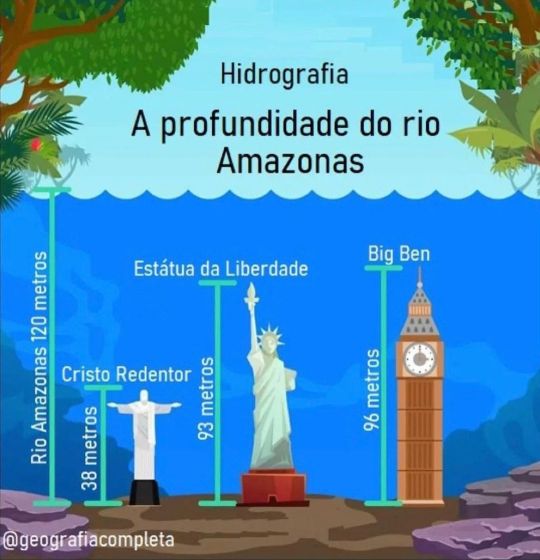
PRESERVEMOS O MEIO AMBIENTE! ✨ O ponto mais profundo do Rio Amazonas alcança os incríveis 120 metros de profundidade. A profundidade média do rio é de 50 m! 😱🥰🌎 Ao desaguar no Oceano Atlântico, o Rio Amazonas, o mais caudaloso do planeta, propicia um dos espetáculos mais grandiosos da natureza, a pororoca, o violento encontro de suas águas com o mar. Num único dia, o Amazonas descarrega no mar mais água que o Tâmisa, na Inglaterra, despeja em um ano inteiro. Tal volume, equivalente a 20% das águas fluviais do mundo, justifica-se pelas fartas chuvas na região, pelo fato de o rio cruzar a maior floresta tropical do planeta e ainda receber mais de 1000 afluentes, alguns com mais de 1 600 quilômetros. A profundidade média do Amazonas é de 50 metros. Em seu ponto mais profundo, a 120 metros, a estátua da Liberdade, de 93 metros, desapareceria. Em média, o rio tem 15 quilômetros de largura – na foz, atinge 300 quilômetros. A vazão média do rio Amazonas é de 215 milhões de litros por segundo. Se ele tivesse de matar a sede de todo o planeta, poderia fornecer um litro de água a cada 28 segundos para cada habitante da Terra. Leia mais em: https://super.abril.com.br/ideias/rio-amazonas-agua-agua/ Via: @geografiacompleta https://www.instagram.com/p/Cj8XbwGpfgf/?igshid=NGJjMDIxMWI=
11 notes
·
View notes
Photo
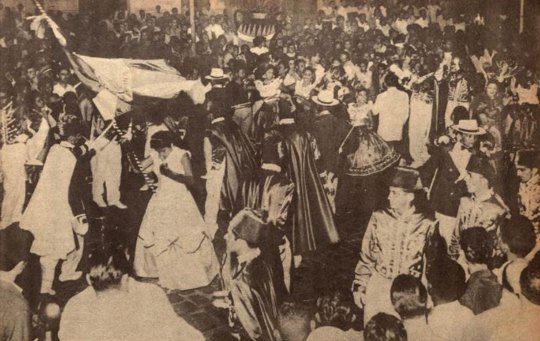


Carnaval, 1957 / Revista Manchete de 23 de março de 1957
(1) “Exibe-se a ‘Universidade do Samba’, bicampeã do carnaval de rua em Belém do Pará. Academismo da ‘bossa’, mais avançado que qualquer concretismo por aí além”.
(2) “Num carnaval e tanto, o povo teve a palavra e mostrou com quantos paus se faz uma canoa. Ritmo em preto-e-branco, para ambos os sexos. Samba até o fundo d’alma”.
(3) “Nº 4: Teresa Catarina, majestade. As três juntas valem bem por uma pororoca”.
“Este ano, Belém do Pará viu o melhor carnaval dos últimos tempos. A alegria dos foliões se esparramou pelas ruas, empolgando-as. Sambistas e passistas iniciaram nova moda, que está ‘pegando’. A Escola de Samba ‘Universidade Boêmios da Campina’ foi a campeã, como em 56. Os Clubes Assembleia Paraense e Bancrevea Recreativa deram a nota, no carnaval de salão, com fantasias riquíssimas. O último elegeu a Rainha do Carnaval, Teresa Catarina, que recebeu uma pulseira de Cr$ 30 mil. Exibição de pernas foi o ponto alto do carnaval de Belém, as fantasias mostrando brotos excelentemente bem despidos. De sábado à madrugada de quarta-feira, quem mandou em Belém foi Momo”.
________________________
Revista Manchete de 23 de março de 1957
3 notes
·
View notes
Text
Riders of the lost waves: Surfing, and saving, Brazil’s pororocas
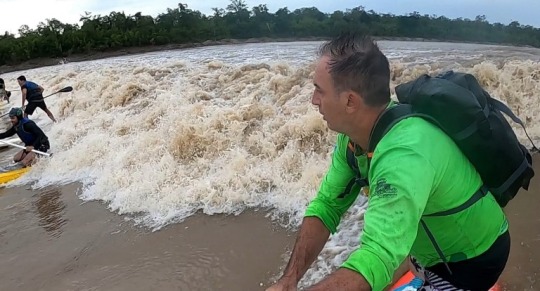
Surfers and volunteers are mapping out tidal bores — spectacular waves that travel dozens of kilometers upriver from Brazil’s Atlantic coast — in an effort to preserve the phenomenon and build a tourism industry around it.
The best-known pororocas in Brazil are in the states of Amapá, Maranhão and Pará, and once included the Araguari River, site of the 2006 world record for the longest distance surfed (nearly 12 kilometers, or 7.5 miles).
But the Araguari pororoca disappeared in 2014 when the river’s mouth silted over, the result of development upriver that included livestock ranching and dam building.
Enthusiasts of the phenomenon now want to develop a Pororoca Park that they say will boost tourism on the Amazon coast, providing income for the Indigenous and traditional communities where many of the remaining pororoca sites are found.
Continue reading.
#brazil#brazilian politics#politics#environmentalism#surfing#sports#environmental justice#mod nise da silveira#image description in alt
8 notes
·
View notes
Note
Top 5 FFI teams? Or just teams in general
Both!!! Both is good! (Thank you so much my dear <33)
FFI (Ina Japan isn't here for obvious reasons):
1. The Kingdom
Obviously, it's my country!! I really like as they are portrayed here fr. The Brazilian irl team is mostly non-white and that is VERY important to portray as this. The designs are really cool and the references aren't just limited to samba. Capoeira and Pororoca (The Amazon River Wave) shows that they took care when researching. It's cool. And of course, we have Roniejo (aka Ronaldinho, the football wizard).
2. Orpheus
Paolo(Fidio) my dear!! All of their drama with Kageyama makes us sympathize a lot with them, and Paolo's friendly and passionate personality It's amazing!
3. Fire Dragon
We have Aphrodi, Suzuno and Nagumo. Period.
I didn't expect this trio to be so badass, I love them so much. Korea is a strong team, nice to see they keep it.
4. Knights of Queen.
They are so obnoxious, I love it. Excalibur It's a very powerful technique and it's cool to see!
5. Desert Lion
Qatar team!! They appear little, but it's enough to steal attention. It's interesting how heat is an important factor! Their design are cool af and imo one of the best.
General Teams:
1. Teikoku
It's pretty obvious by how often I draw them lmao. Cool team with a bunch of sassy brats. Perfect.
2. Raimon
Impossible not to like. They are the protagonists and obviously have the coolest characters (I love you someoka)
3. Osaka Gals CCC
My beloveds. An all-girl team, I'd really like to see more of that and more hissatsus. Most think this team is a bit silly but I like it.
4. Oumihara
otomura is my son. that's all i have to say.
5. Occult
Wtf they have Dracula on the team. Cool.
Yay, that's all! Thank you so much Krongulous <3
3 notes
·
View notes
Text
A cantora do Pará, Thays Sodré, lança o seu álbum de estreia, "Flor do Destino", ao lado do produtor Rodrigo Garcia (Cássia Eller, Zélia Duncan, Cátia de França, Chico Chico). Por meio do Selo Porangareté a jovem cantora apresenta ao mundo um disco que é fruto de paisagens paraenses e ritmos nordestinos, transformando em música tudo aquilo que fala ao coração e que brilha ao ser interpretado pela doce e potente voz de Thays. O álbum sucede os singles "Tudo é Bom e Nada Presta" (Cecéu), "Não Vou Sair" (Celso Viáfora), "Carimbó da Pororoca" (Irelson Capim Show) e "Confissão" (Thays Sodré).
Ouça “Flor do Destino”: https://bfan.link/flor-do-destino
“Este é um álbum que representa o meu desabrochar como uma artista que canta as suas raízes paraenses e também as influências que recebeu de outras partes do Brasil que se descortinam na minha caminhada em direção ao sudeste. É uma felicidade cantar a minha terra paraense, tão brasileira quanto qualquer outro canto, e o meu canto que naturalmente se veste de carimbó e brega, também adora o forró, o samba, a canção… e tudo isso me faz feliz, ver o quão diverso e rico é o Brasil que é tantos num só”, declara Thays Sodré, cantora, intérprete e compositora.
O processo do disco “Flor do Destino” começou ainda em 2021, quando Thays Sodré e Rodrigo Garcia, produtor musical, diretor artístico e fundador do selo Porangareté se conheceram na internet, enquanto este procurava cantoras para realizar um álbum de forró pé-de-serra. Na época, Thays morava no Rio de Janeiro e participava do grupo Amargô, mas não demorou muito para que a cantora visitasse o estúdio e assim começasse a abrir as primeiras guias que originaram o disco de 12 faixas.
“No começo eu não tinha muita ideia de qual repertório o álbum teria, foi um caminho de descoberta, de desabrochar, assim como o que hoje o ‘Flor do Destino’ simboliza. Mostrei algumas canções minhas pro Rodrigo e daí entraram para o disco ‘Confissão’ (Thays Sodré) e ‘Encanto’ (Thays Sodré / Rodrigo Garcia). Nesse caminho, voltar o olhar para o Pará foi inevitável, as raízes pulsantes com a MPP - Música Popular Paraense, o carimbó, o brega… A cada momento uma canção fala ao coração e a faixa-título "Flor do Destino" (Nilson Chaves / Vital Lima) ficou na minha cabeça por semanas. Fiquei em dúvida se entraria no repertório ou não, por ser uma música que já era um sucesso no Pará, gravada pelo Nilson e pelo Vital que são grandes referências pra mim, evidenciando as minhas influências e pelo sentido a canção deu ao álbum, decidimos que ela entraria, e desde então ela foi o Norte.”, relembra Thays.
A influência da música paraense transborda na musicalidade de Thays Sodré, que busca trazer mais fãs para a arte produzida em seu estado natal.
“A música paraense, na verdade a música dita regional, é pouco difundida nos grandes centros. A música do Sudeste chega ao Norte, mas a música do Norte por vezes não chega com a mesma força no Centro Sul. Sinto que o Nordeste tem quebrado essa barreira ao longo dos anos, o que não vemos na mesma proporção com a música Nortista. Que as pessoas estejam abertas a conhecer, a se encantar, que se surpreendam e que também possam amar o Norte como eu amo. Porque só amamos o que temos o prazer de conhecer. ‘Modéstia à parte, seu moço, minha terra é uma belezinha’ (Todos Cantam Sua Terra - João do Vale e Julinho do Acordeon)”,
Antes mesmo de ser lançado, o disco “Flor do Destino” conta com prêmios: a canção “Para nos Molhar”, composta por Gui Fleming, ganhou prêmios no Festival da Canção de Rio Bonito e no Festival da Canção de Bela Vista de Minas. Já Thays, como intérprete, acumula prêmios em sua carreira como “Melhor Intérprete”, no Festival da Canção de Bela Vista de Minas - MG (2023) e no Festival Nacional Forró de Itaúnas - ES (2019).
A paixão de Thays Sodré pela música vem desde sua infância, começou por meio da flauta-doce, ainda quando morava em São Domingos do Capim (PA). Com o passar do tempo, se aperfeiçoou também no violão e clarinete.
Suas influências musicais remetem à esta época, com nomes como Waldemar Henrique, Luiz Gonzaga, canções católicas - graças à influência da música e o “Tio Neno”, seu mentor na música - e também ícones da Música Popular Paraense, como Nilson Chaves, Lucinha Bastos, e nomes do cancioneiro popular brasileiro, como Cássia Eller, Kid Abelha, Zé Ramalho, Zeca Baleiro, Adriana Calcanhoto e Caetano.
“Chegando no Rio de Janeiro, em 2012, a diferença de sonoridades me surpreendeu. Me apaixonei por Dominguinhos, Anastácia, Cecéu, Antônio Barros, João Silva, Marinês, Gonzaguinha, Gilberto Gil, Luiz Gonzaga novamente, de maneira mais efetiva. Cátia de França, com suas letras intrigantes, Geraldo Azevedo com seu encanto em compor e cantar canções, Chico César, Belchior…”, conta Thays.
As mulheres da música brasileira conta com uma admiração particular - e muito apaixonada, como define a cantora:
“Como inspiração tenho num lugar especial as intérpretes: Elba Ramalho, Clara Nunes, Gal Costa, Elis Regina; Fafá de Belém, tem um trabalho primoroso, e me identifico muito com o "Tamba-tajá", seu primeiro disco, gosto da mistura, dos sons da floresta, da voz como ela é, com risos e manhas, de interpretação marcante, uma das rainhas da Amazônia. As performers também me encantam, Ivete Sangalo e Joelma, acredito que um show não é apenas musical, é visual, é o conjunto da obra, acho incrível a habilidade de cantar e dançar combinadas, é desafiador.”
O disco “Flor do Destino” traz em sua ficha técnica nomes como Rodrigo Garcia (direção musical, produção musical e mixagem), Marcelo Bernardes (arranjos de sopros) e Evaldo Luna junto a Rodrigo Garcia (masterização). E ainda, Emerson Ferreira (arte e design da capa), Thiago Araújo ( ngulo Criativo - foto da capa), Edlene Sodré (assistente de fotografia), Andréia Santos (figurino) e Andressa Larama (beleza). A produção executiva é de Raphael Parett e Jhasmyna Thuller.
Alguns dos músicos que participam do disco são Thays Sodré (intérprete, voz, caxixi e triângulo), Alex Merlino (bateria, conga e pratos), Cosme Vieira (sanfona), Daniel Zanotelli (flautas, sax e sopros), Durval Pereira (zabumba e percussão), Évila Moreira (banjo paraense), Jhasmyna Thuller (coro, voz e vocais), Meninão (sanfona), Marcelo Bernardes - (sopro, clarinete, flautim, flautas e arranjo de sopros), Marcos Suzano (pandeiro,bongô e cuíca) e Rodrigo Garcia (arranjo de base, baixo, guitarra, guitarra slide, violão, violão aço, violões, viola caipira, cavaquinho, percussão, coro e arranjo).
Acompanhe Thays Sodré
Instagram: www.instagram.com/thayssodreoficial
Youtube: https://m.youtube.com/channel/UCSC_MFWNXcokLm_RVQj4H-A
Facebook: www.facebook.com/sodrecantora
Porangareté: https://porangarete.com.br/index.php/artist/thays-sodre/
0 notes
Text
Re: Did Farragut Ever Experienced Tsunami? 🌊
In the original post, @aceofthyme commented:
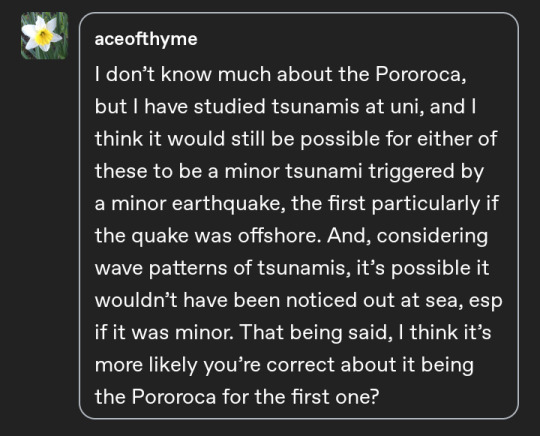
I don't know much about the Pororoca, but I have studied tsunamis at uni, and I think it would still be possible for either of these to be a minor tsunami triggered by a minor earthquake, the first particularly if the quake was offshore. And, considering wave patterns of tsunamis, it's possible it wouldn't have been noticed out at sea, esp if it was minor. That being said, I think it's more likely you're correct about it being the Pororoca for the first one?
.
Alright, let's examine the points one by one.
First of all, how does an earthquake happen?
Earthquakes occur anywhere on the earth where there is sufficient stored elastic strain energy (think of the tip of a ruler fixed at the edge of a table. One end hanging off the edge, and then you press down on the hanging end, hold it a little while and then release it. It's vibrating rapidly up and down — that's the kind of energy we're talking about) to drive fracture propagation along a fault plane. The fracture propagation causes strain seismic wave (ie. the tremor, "quakes" one feels during an earthquake event), this happens at a fault line (ie. a line where two continental plates meet).
There are other causes of earthquake aside from tectonic ones, but the tectonic cause is the one most relevant to the topic we are discussing now.
There are three fault types, and all of them could cause earthquake.
•normal thrust fault (earthquakes from this fault tend to measure lower on the magnitude scale, compared to the ones caused by other types of faults)
•strike-slip fault (think of San Andreas Fault in California, US. Intermediate in strength, between normal and reverse thrust fault.)
•reverse thrust fault (this is the type of fault that gives really BIG earthquakes (8.0 and up), such type of earthquakes are also called megathrust earthquake (from how deep one tectonic plate goes under the other, which makes the other plate "bend" so much until it finally snaps back into its original position))

Types of Faults (source: Washington State Earthquake Hazards, Washington division of Geology and Earth Resources Information Circular 85, 1988)
.
Where do you find (tectonic) faults? Tectonic faults are found wherever there are two tectonic plates "meeting" each other — tectonic plate boundary. There are three types of of plate boundary
•divergent (the plates are moving away from each other, from the boundary line)
•convergent (the plates are moving towards each other, to the boundary line)
•transform (the plates' edges merely "touch", neither towards nor away from each other — the plates move horizontally against each other¹)
Reverse thrust faults are found on convergent plate boundary, normal faults on divergent boundary, and strike-slip faults on transform boundary.
(1: anyhow a little aside on transform plate boundary — remember San Andreas Fault, and the misconception that one day California is gonna fall off to the sea? Well, the reason that is a misconception is that San Andreas Fault is a strike slip fault — a transform plate boundary! So yeah, much as the plates are moving against each other, they are definitely not moving away from each other.)
.
So, that's an explanation about earthquake, what about tsunami? What caused a tsunami?
There are various causes to tsunami, from volcanic eruption to landslide by the sea to even meteorite (...yes, that), but again, for our topic the most relevant type would be the seismic cause — in another word, tsunamis triggered by earthquakes.
The most common type of fault causing earthquake (and then tsunami) is the reverse thrust fault. Earthquakes caused by normal fault activities could also trigger tsunami, but it is exceedingly rare. To determine whether an earthquake could trigger tsunami, one should not just see the type of the fault causing the earthquake, one should also measure how strong the earthquake is. As far as earthquakes have been able to be quantitatively measured (using first the Richter, later Moment Magnitude scale), tsunami-triggering earthquake usually measures at 7.5 Mw, sometimes (well, often actually) even stronger than that.
Keep that number in mind.
.
Bearing that in mind, what was the big surge of wave in Paraíba, Brazil that Farragut encountered likely to be? And what about the one he encountered some 130 miles away from Anguilla?
Let's go with the Brazil case first.
So, what could possibly trigger an earthquake off the Brazilian coast? For one thing, there's a tectonic plate boundary in the middle of the Atlantic ocean — Mid-Atlantic Ridge. What kind of tectonic plate boundary is Mid-Atlantic ridge? It's a divergent boundary (which would have normal fault as the active fault in turn — the thing that could potentially trigger earthquakes and tsunami), so while it could cause earthquake, it wouldn't exactly trigger tsunami.
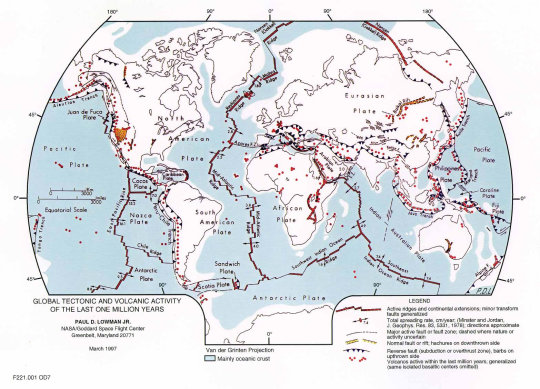
BTW this map also notes the types of tectonic plate boundaries, and as you can see from the arrows pointing away from the line, Mid-Atlantic ridge is a divergent boundary.
.
But wait — you said a normal fault could still trigger tsunami??
Yes, but as I said, it is exceedingly rare. The last time it happened (in Sumba, 1997), the normal fault off the southern coast of Sumba Island caused an earthquake measured at 8.0 Mw, which triggered a tsunami. So from this case, you could infer that while it takes earthquakes as strong as (or stronger than) 7.5 Mw to trigger tsunami (from a reverse thrust fault), it takes an earthquake (caused by a normal fault) with an even stronger moment magnitude (8.0 in this case).
How strong earthquakes from Mid-Atlantic ridge could be, then?
Here's a map of recorded earthquakes in every tectonic plate boundary on earth, measured in the 20th century (from 1900 to 2017 to be precise).
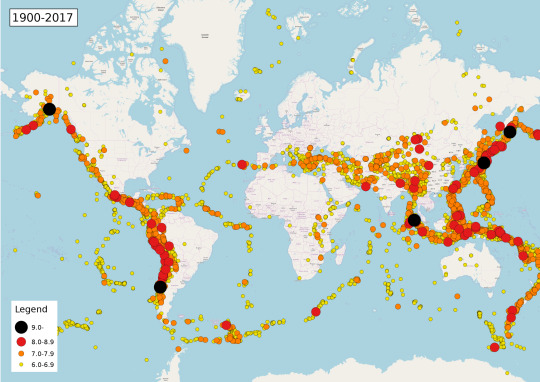
Let's zoom in closer to Brazil.
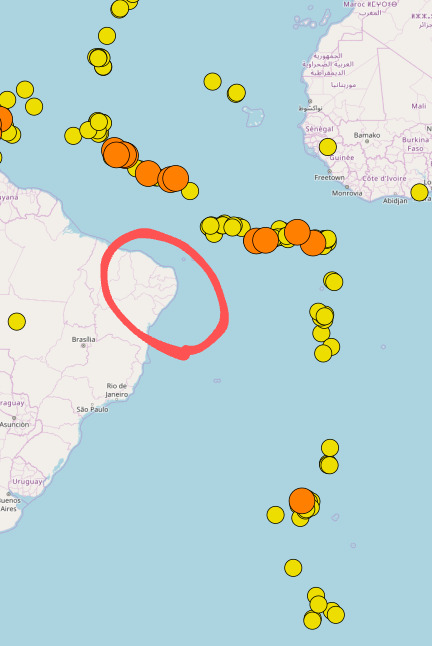
Boa Vista (in Paraíba) is within tbe region encircled in red.
As you can see on the map, the biggest magnitude of earthquakes measured (with epicenter from the Mid-Atlantic ridge) only measured up to 7.9 Mw at most. One should probably account how the grounds around the epicenter at the Mid-Atlantic ridge got displaced too, to see if the earthquake could trigger tsunami. That said, at the moment I am leaning more towards no — neither the magnitude was strong enough, nor the fault type would have caused tsunami in Brazilian coast off Paraíba.
So with all that said, I am more convinced what what Farragut encountered in Boa Vista around November 1842 is likelier to be pororoca instead of fully fledged tsunami.
Wait wait, what's pororoca again??
Pororoca is a tidal bore caused by the gravitational pull of the moon (and in some alignments, like in spring equinox, the sun), which is so strong it could reverse the flow on the Amazon river momentarily. At its peak strength it could travel inland and upstream as far as 800 km (500 mi).
(and yes, it has a characteristic loud roar, which makes pororoca extra remarkable).
.
And now, let's talk about the one in the Carribean — 130 miles off Anguilla.
Let's look again at the tectonic plate boundaries map, zooming in this time.

Hmmm, what is that?
If you remember the legend, the line with arrowheads indicates a reverse thrust fault.
Let's look at another map for a better look.

Anguilla is located to the right of the red dot (map source)
As you can see, the subduction trench — the reverse thrust fault (also with a similar legend) — is located at some 200 to 300 km to the east of Anguilla. Bear in mind the fault type — it's the fault that most likely to trigger a tsunami.
Now you see the recorded earthquake magnitude map, and you see that there are a few recorded earthquake with magnitudes measured at 7.0 Mw and stronger. One could definitely encounter an earthquake with an epicenter somewhere on the fault, with a magnitude of 7.5 Mw or stronger (which could trigger a tsunami).
And to top it all...
There was a recorded megathrust earthquake with the epicenter located on this fault line!
It happened in Guadeloupe, 8 February 1843, with a suggested magnitude of 8.0 Mw. In my view, it is likely that this earthquake would have triggered a tsunami as well.

And to remind you on how things lay, here's a map showing where Guadeloupe is located (roughly SSE to Anguilla). The earth
It would have been great if the dates were written in the biography (because unfortunately it weren't written down 🤦🏾🤦🏾🤦🏾), but it was written down that Farragut only reached Chesapeake Bay in 11 February 1843 — the tsunami that he might have experienced could very well have been triggered by the earthquake happened on Guadeloupe (which would also explain that despite his ship sailing somewhat close to the fault line, the waves that he experienced was very strong, lasting a few minutes).
So that's how I came to my thought of the great waves that he experienced in the Carribean were likelier to be a tsunami (compared to the one he experienced in Brazil).
To broadly summarize...
The fault line in Brazil
1. is not the *right* fault type (normal fault), and even then,
2. the earthquake magnitude couldn't be great enough to trigger tsunami.
While the fault line in the east of the Carribean
1. is the *right* fault type (reverse thrust fault)
2. the earthquake magnitude could be great enough to trigger tsunami, and
3. there is a recorded megathrust earthquake around the time period (in which we focus our observation).
And that, I think, covers all the points in your response.
#writings#this was quite the writeup whoa#now this is either way superlate- or superearly-#farragut friday#lmao 🙈#geophysics#seismology#geology#maritime history#american history#earthquake#tsunami#well y'know at least this is a substantial write up 🥲#written as a response#not sure how else to tag it 🙈#geoscience#history#david farragut#david glasgow farragut
2 notes
·
View notes
Text
A pororoca moral do Brasil é o encontro das ONGs com a desordem nacional
youtube
View On WordPress
0 notes
Text
Nexusmon

Nível Perfeito
Atributo Livre
Tipo Dragão Sagrado
Campo Destruidores de Vírus (VB) / Rugido do Dragão (DR) / Salvadores das Profundezas (DS)
Significado do Nome Nexus, Elo em Inglês
Descrição
Uma criatura magnífica que surgiu a partir de uma Jogress milagrosa, a fim de derrotar um poderoso demônio que aterrorizava a Ilha Arquivo. Como é a junção de dois Digimons no estado de Pororoca, era teorizado que esta forma seria tão instável quanto as anteriores, mas o que realmente aconteceu foi o contrário, como se um tivesse completado o outro.
É um guerreiro honrado que se manifesta em calamidades afim de socorrer os justos e puros de coração, principalmente Bebês e Crianças, fazendo-o ser conhecido como o Guardião dos Começos, pois um de seus maiores deveres é o de garantir que os pequenos tenham a oportunidade de crescer e se desenvolver.
A Aura Iridescente que o envolve, além de belíssima, possui propriedades incendiárias e congelantes que são perigosas para criaturas malignas e corruptas, por isso ele a usa para proteger os bondosos criando uma extensão dessa Aura em volta deles (Iris). Também tem o poder de comandar os raios através da lâmina em seu braço direito, a Rakuen no Arashi Ha, capaz de absorver grandes concentrações de energia para poder desferir golpes devastadores contra os emissários do caos.
Ainda que seja uma força tão necessária para a manutenção da ordem no Mundo Digital, suas aparições são muito breves e nunca é certo quando ele voltará a aparecer, mas uma coisa é certa: sempre que catástrofes ameaçarem a vida das crianças, Nexusmon estará lá para impedir.
Técnicas
Iris Cria uma extensão de sua Aura em volta de um ou mais Digimons que deseja proteger.
Tenryuusei (Meteoros Celestiais) A luz em seu peito se intensifica, então são criadas 15 esferas de energia à sua volta, que ao comando de Nexusmon são atiradas no inimigo em uma velocidade impressionante.
Rakuen no Arashi Ha (Lâmina Tempestuosa do Paraíso) Concentra a energia dos raios na lâmina em seu braço direito, então ataca o adversário com um corte dilacerante ou uma poderosa estocada.
Tenshi no Tabi (Jornada dos Anjos) Expande a Aura de suas asas, carrega energia no propulsor em suas costas e voa contra o oponente em alta velocidade. Conforme avança, várias criaturas aladas feitas da Aura de Nexusmon surgem e o acompanham durante o voo, até atingirem o oponente. O impacto causado pela investida destrói os dados inimigo e o reduz à um Digitama.
Linha Evolutiva
Pré-Evolução
Heatmon: Pororoca + Peixemon: Pororoca (Jogress)
Artista Jonas Carlota
DigiDex Empírea
#DMEDex#digimon#digital#monster#rebuilt#rebuiltproject#OC#original character#Fanmade#digifake#Fakemon
26 notes
·
View notes
Text
Cozinha Bruta: As 7 roubadas capitais dos bares brasileiros
Segue a lista, na seguinte ordem: do pé-sujo ao speakeasy.
1. Torre de chope
Uma das ideias mais cretinas da história moderna, a torre de chope é um prodígio do design. Combina estética horrenda com o fracasso absoluto da funcionalidade.
Basicamente, o cara do bar despeja uma pororoca de chope num recipiente do tamanho do piscinão do Pacaembu. Nesse processo, a bebida já perde metade do gás. E aí…
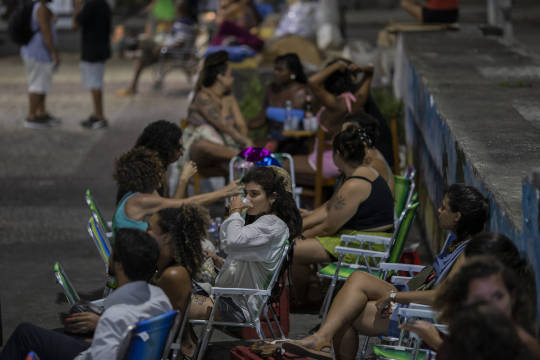
View On WordPress
0 notes
Text
Brésil : la Pororoca, la vague géante de l'Amazonie admirée des surfeurs
Chaque année au Brésil se forme une vague interminable sur des dizaines de kilomètres. Une vague quasiment sacrée pour les Amérindiens et pour les surfeurs.
0 notes